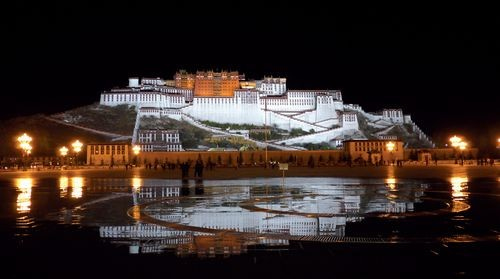
Lhasa, capital city of Tibet Autonomous Region, is famous for its legendary history and mysterious Tibetan Buddhism, but it's also a fascinating scenic tourist city to escape from all types of gridlock during public holidays.
Unlike other tourism-heavy cities where the only scenery left is crowds during holidays, Lhasa's traffic was much thinned out the night when we arrived, even though it was the first day of the weeklong National Day holiday. Smells of food and notes of distant song floated in the fresh air and we could occasionally spot Lamas wearing red and yellow robes while our bus was rolling along the streets.
"You will be safe the whole journey if you are safe the first two days," our tour guide, Hu Anping, said of altitude sickness on our way to the hotel. The sensational sickness really did not trouble me much, so did the rest of our 16 members. It was just two nights of slight headache and insomnia, so totally not worth concerning it too much. But you do need a sound sleep before starting your adventure in Lhasa.
Potala Palace
Located in the highest place in the world, Lhasa is fully favored by sun and gets more than 3,000 hours of sunshine every year. It rises over 3,600 meters above the sea level, while the world-renowned Potala Palace rises a further 117 meters.
Potala Palace is a great place to understand Tibetan Buddhism, and it's also a significant reason why hundreds of thousands of visitors worldwide visit Lhasa every year.
The palace, built in the 7th century, was extremely bright and magnificent under the blue sky, and it has over 1,000 rooms in its Red and White palaces. The lower White Palace served as the residence of Dalai Lamas, and the upper Red Palace was the religious area and contains stupa of the Dalai Lamas, except the sixth who wrote lots of love poems that are still popular in China to this day.
Potala Palace has a strict limitation on the number of everyday tourists. Starting from 2006, the palace restricted tourists to 2,300 every day. A tour group can only have less than 30 tourists, and the visiting time is limited to only one hour.
Thus, no matter if you are traveling on your own or with a tour group, you have to make a reservation a day ahead to buy the palace tickets. Passports or ID cards are required to buy the 200-yuan ($ 31.36) ticket.
Thanks to the time and tourist number limitations, the Potala Palace is always quiet and harmonious. You can occasionally see solemn-faced Tibetan Buddhists, children or elderly people, mumbling while adding butter to the lighted candles inside the palace.

Copyright ©1999-2011 Chinanews.com. All rights reserved.
Reproduction in whole or in part without permission is prohibited.